Why you should be grilling with mayonnaise
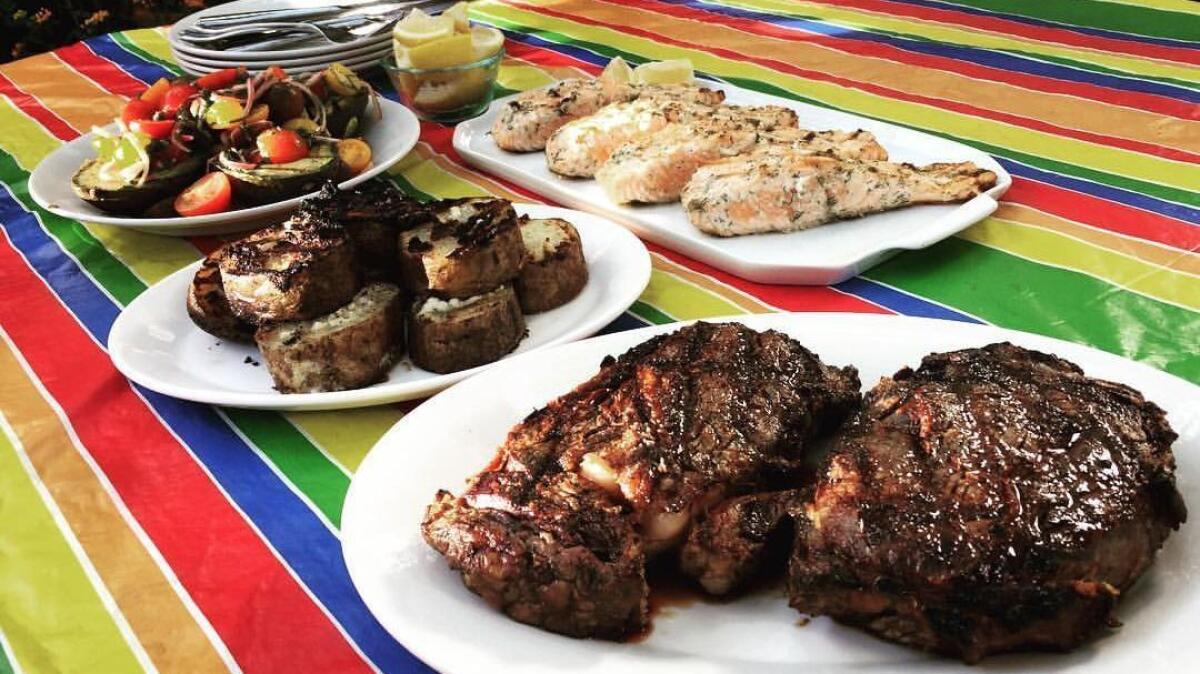
For many of us, summer doesn’t officially commence until we fire up the grill. This is the season of outdoor parties and cookouts, as those of us self-professed grill masters and weekend warriors deftly show off our live-fire cooking skills in front of family and friends. That is, until the grill flares up and those beautiful steaks are reduced to charcoal and we’re peeling them off the grill through a cloud of smoke.
It’s an all-too-common tragedy played out in backyards everywhere. What if there was an easier way?
My challenge was always fish, which would glue itself to the grill whether I oiled the fillets, or the grill racks, or both. But then I noticed chef Michael Cimarusti lightly brush delicate halibut fillets with mayonnaise before grilling. Yes, mayo — the stuff of cafeteria bologna sandwiches and picnic potato salads. Cimarusti, who knows his fish, is chef and owner of Providence, No. 1 for the last few years on Jonathan Gold’s 101 Best Restaurants List. He uses the technique at the restaurant, and when I asked him about it, he explained the mayonnaise keeps the fish from sticking to the grill. He adds a very thin layer, “so it’s almost not there.”
This isn’t the first I’d heard about cooking with mayonnaise. It’s often touted as the fat of choice, particularly when making a grilled cheese sandwich. Dave Danhi, founder of the Grilled Cheese Truck, slathers a combination of butter and mayonnaise on the outside of his sandwiches before cooking.
“I’ve done it since the beginning,” said Danhi, formerly chef at fine-dining restaurants including the Water Grill, touting the golden-brown crust it gives the sandwiches. He argues that the addition of mayonnaise raises the smoking temperature so the sandwiches don’t burn on the griddle.
But what about the grill?
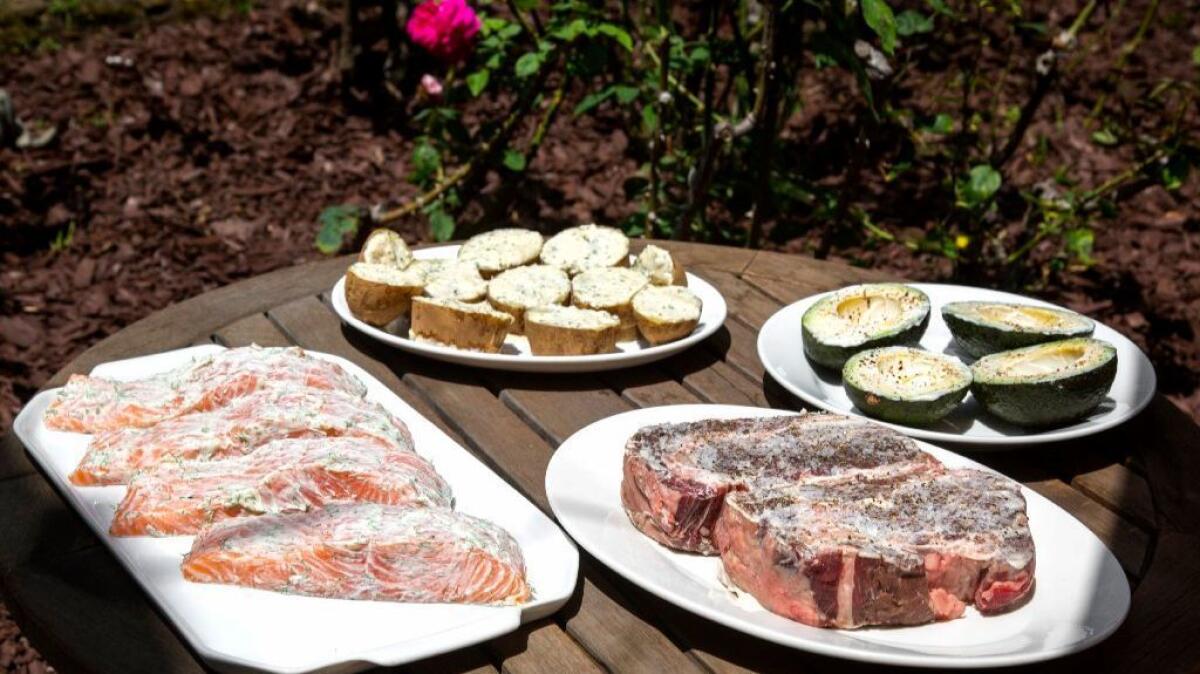
The science of mayonnaise and heat
“This is an area I’m playing a lot more with now. Mayonnaise really works,” said Meathead Goldwyn, founder of the popular website, AmazingRibs.com and author of “Meathead: The Science of Great Barbecue and Grilling.” “It sticks really well to the food, helps release food from the hot grill surface, and gets a beautiful golden color.”
Part of the reason mayonnaise works so well is because of its composition. “Mayonnaise is an emulsion, which means you have small droplets of oil surrounded by egg yolk, and that has a couple of really cool properties,” said Greg Blonder, professor of product design and engineering at Boston University and co-author of Goldwyn’s cookbook.
There is something magical about mayonnaise."
— Meathead Goldwyn, founder, AmazingRibs.com
This emulsion allows the oils in the mayonnaise actually to stick to the food, unlike plain oil. Oil and water don’t mix, which is why it’s so hard to get the fat to adhere to foods you want to grill, particularly meats. So as you grill, you’re left with a very limited amount of oil to keep the food from sticking. Additionally, as the oil runs off, it’s likely to result in more flare-ups.
“Mayonnaise acts like little time-release oil capsules, and you can put it on thick. And the emulsifiers like to stick to the meat,” Blonder said. Mayonnaise is a great release agent for meat, and is particularly helpful for grilling chicken and fish.
And where oil only heats and browns the food thermally, mayonnaise is able to brown food chemically — that golden-brown color — through what is known as the Maillard reaction. The Maillard reaction requires sugars and proteins to work; as these are heated, the nonenzymatic reaction produces browning. “When you just put regular oil on meat, it doesn’t bring these to the table. It only brings fat,” Blonder said.
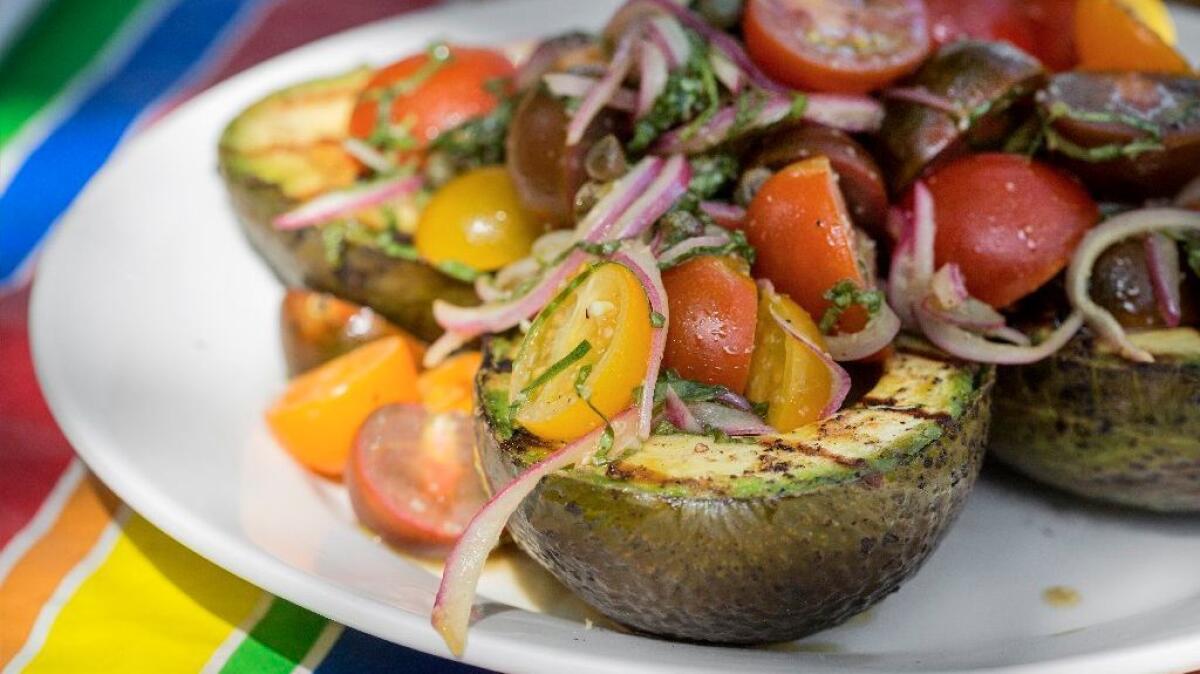
Recipe: Grilled avocado with marinated tomato salad »
Finally, mayonnaise may help foods retain moisture as they cook on the grill, so foods — particularly meats — don’t dry out. “Chicken breasts — they’re the world’s driest food. Mayo is one way to make them moist,” Goldwyn said.
Though he hasn’t formally tested moisture retention yet, Goldwyn said he believes the mayonnaise might actually help to keep food tender. “If nothing else, the mayo evaporates under the heat rather than the moisture in the meat,” he said, arguing that the meat won’t dry out.
"Mayonnaise contains proteins and sugars, which can kick off the Maillard reaction when you grill. Oil doesn't bring these to the table; it only brings fat."
— Dr. Greg Blonder, professor, Boston University
He compares it to the baste that pitmasters use when cooking tough cuts for long periods over low heat. The baste is what evaporates, rather than the moisture in the meat. “But the baste drips off and evaporates pretty quickly, so you’re not getting a great deal of benefit,” Goldwyn said. He said he thinks mayonnaise might give more benefit as a baste. “I haven’t tried it on a pulled pork or, heaven help me, on a brisket. But I’m getting ideas now.”
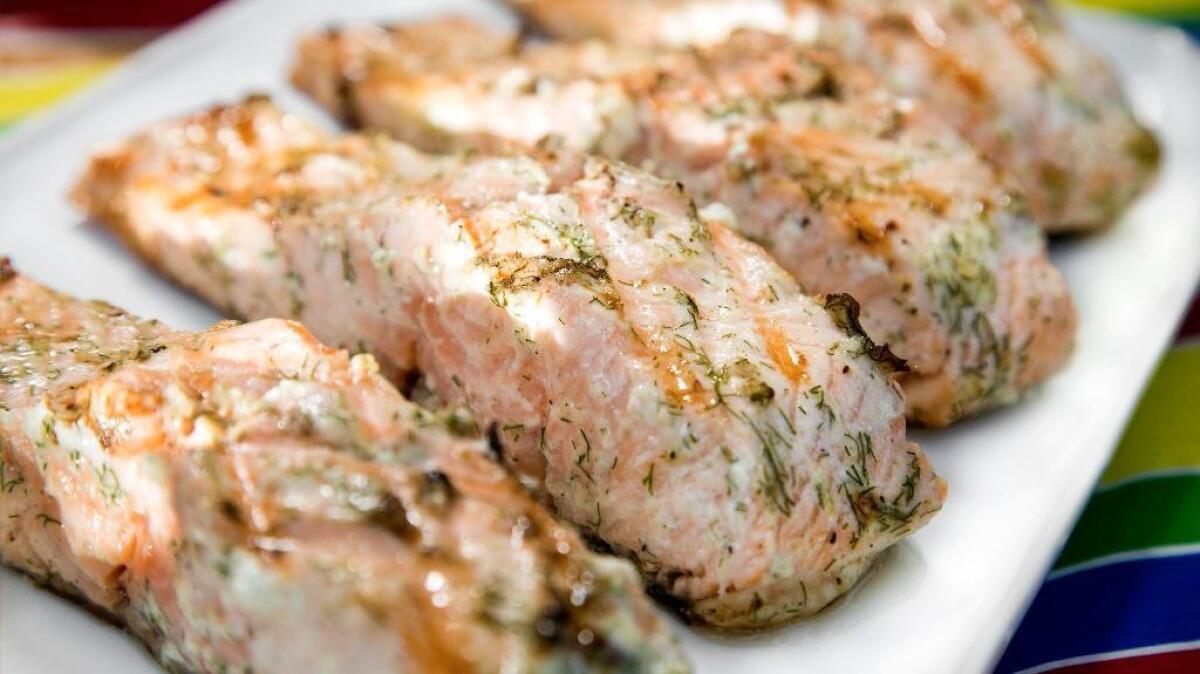
Recipe: Grilled salmon with dill »
Mayo mojo
Perhaps one of the reasons people may be afraid to try mayonnaise is flavor. “They think it will add flavor. But that’s the thing. It doesn’t alter the flavor” of the food, Goldwyn said.
If anything, mayonnaise works well as a vehicle for other flavors. “It’s a white canvas you can flavor with almost anything,” Goldwyn said, including just about anything in your spice rack. “You can add all kinds of stuff to it. I call it mayo mojo.”
In the last couple of weeks alone, I brushed mayonnaise on everything I’ve grilled, from chicken breasts to pork chops, asparagus to mushrooms. When I added a dill-flavored mayonnaise to salmon, it was as if I was grilling on Teflon, the fish released so easily. I almost felt like I was cheating.
For what it’s worth, allegiance to mayonnaise brands can spark as much debate as politics or religion.
“This country is divided into — not Democrat and Republican — but Hellman’s and Miracle Whip,” Goldwyn said. Personally, I’m a Best Foods (or Hellman’s, as it’s known in other parts of the country) fan, and haven’t tried grilling using Miracle Whip, though I did use an olive oil-based store brand I found in the back of the fridge when my Best Foods stash ran out last week, and everything grilled up just fine. (I also frequently use Kewpie — a Japanese mayonnaise, and a favorite of some of my chef friends — on my grilled cheese sandwiches.)

Recipe: Perfect grilled steak »
Goldwyn recommends using mayonnaise for garlic bread on the grill, and slathers a flavored mayo to add a crust to cooked baking potato slices — “They get crunchy, like those coated French fries.” I mentioned one of my favorite meals is a simple steak sprinkled with Maldon salt and freshly cracked pepper. Would mayonnaise work on steak, I asked him over the phone? Goldwyn paused to consider. “Well, why not?” he decided.
For the record, I brushed a thin layer on prime rib-eye steaks just the other day. It worked perfectly.
Mayonnaise is a blank canvas and you can add all kinds of stuff to it — just about anything on your spice rack mixes well with mayonnaise."
— Meathead Goldwyn, founder, AmazingRibs.com
20 things to grill using mayonnaise:
- Halved lobster; with mayonnaise flavored with garlic, paprika and lemon zest.
- Thick slices of cooked baking potatoes; with mayonnaise, garlic, rosemary and Parmesan cheese.
- Shishito peppers; with mayonnaise flavored with sesame oil, soy sauce, garlic and rice wine vinegar.
- Eggplant slices; with tapenade-flavored mayonnaise
- Lamb chops; with mayonnaise, flavored with mint, rosemary and anchovy.
- Chopped fingerling potatoes; with mayonnaise, garlic and thyme.
- Chicken wings; with chipotle- or Sriracha-flavored mayonnaise.
- Grilled onions; with mayonnaise flavored with sherry vinegar and fresh thyme.
- Shrimp; with mayonnaise flavored with chermoula.
- Burger buns; with a thin layer of mayonnaise before toasting.
Recipe: Grilled potatoes Parmesan garlic and rosemary »
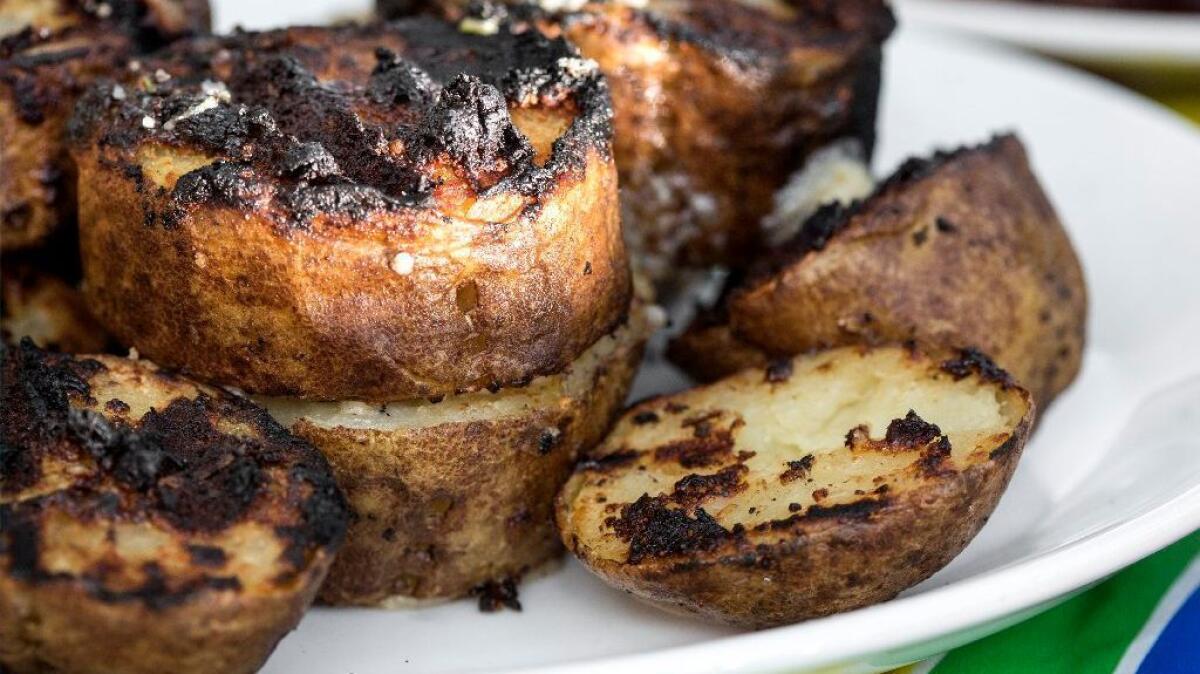
Instagram: @carternoelle
Twitter: @noellecarter
ALSO
Beer can chicken on the grill takes a twist
In Providence’s kitchen: Using the whole fish
What makes a perfect grilled cheese sandwich? We ask the chef behind the Grilled Cheese Truck
Eat your way across L.A.
Get our weekly Tasting Notes newsletter for reviews, news and more.
You may occasionally receive promotional content from the Los Angeles Times.






